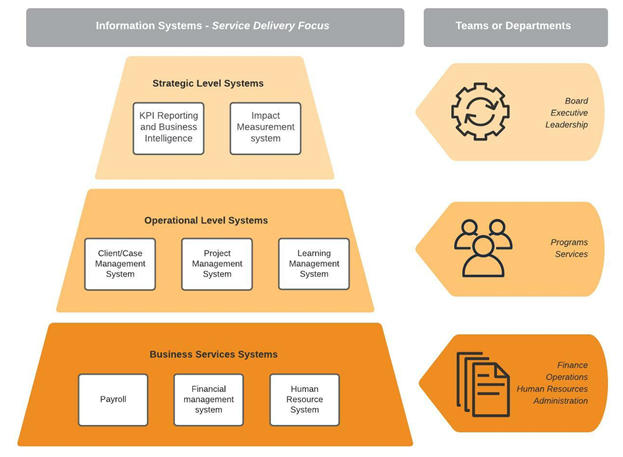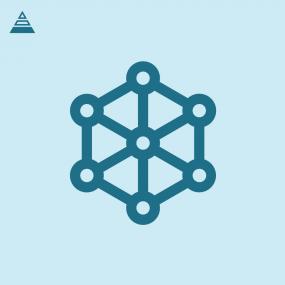What are information systems?
An information system is a combination of hardware and software components, processes and people that interact to capture, store, process, manipulate, analyse and display data.
Not-for-profit organisations rely on information systems to carry out and manage their operations, interact with their supporters and support their clients.
Varieties of information systems
There are many kinds of information systems performing countless tasks. One might support the delivery of counselling services, another might assist an environmental organisation track endangered fauna.
Broadly speaking, there are six kinds of information systems:
Service delivery systems:
-
Client/case management systems: help provide services to people in need and report to funders.
-
Constituent relationship management (CRM) systems: track communications with constituents, fundraising activity, donors and/or membership status (important for peak bodies and membership-based organisations).
-
Another more specialised (and often unique) system to track and manage specific items, such as flora, fauna, historical artifacts, environmental conditions, etc. These systems don’t generally exist ‘off the shelf’ and often need to be built (or heavily customised).
Digital service delivery systems (remote program delivery): systems enable services that do not require in-person participation such as webinar platform, online event systems, videoconferencing platforms.
KPI reporting and business intelligence: measure business metrics and assist with tracking and analysis.
Impact measurement systems: measure the impact of a program and can help identify opportunities and refine services.
Human resources information systems: collect and store staff data and assist with recruitment, performance management and professional development.
Financial management systems: assist with financial management processes such as transaction histories, journal entries and bookkeeping, and are used to produce reports such as income statements and balance sheets.
Potential problems
Ineffective, inappropriate or unreliable systems can compromise service delivery and frustrate staff. Service delivery benefits from the use of reliable, coordinated systems that can be accessed from anywhere and capture comprehensive information regarding clients, stakeholders, services and interactions.
If you don’t have the right information system, your organisation may be challenged by one or more of the following problems:
- information duplication and inconsistencies
- difficulty in tracking service history for a single client/ supporter because of multiple, incompatible systems
- difficulty in tracking funding targets, workload and waitlists.
How not-for-profits use information systems
Here’s how information systems might be used by two different types of not-for-profit organisations – a service delivery organisation and an advocacy/fundraising organisation.
Types of information systems used in a service-delivery not-for-profit
For an organisation whose focus is service delivery, the chart below illustrates the various information systems that help it run effectively. They are shown from the executive to operational levels.

Information systems used in an advocacy/fundraising not-for-profit
For organisations with more of an advocacy and fundraising focus, the chart below illustrates the types of information systems that may be used. These organisations might use a donor management system to manage their fundraising activities, a volunteer management system to enrol volunteers, and an event management platform to organise free and paid events.

Information systems capability levels
|
Basic |
Intermediate | Advanced | |
|---|---|---|---|
| Service delivery system(s) | Staff often find the system (or systems) we use to deliver our services frustrating. |
Staff use one or more systems to support service delivery. Systems are reliable, can be remotely accessed and capture comprehensive data about clients/stakeholders and services/interactions. Deficiencies exist, such as data entry duplication, multiple systems, difficulty tracking funding targets and/or workloads and waitlists. |
Our system is intuitive and works well for clients/members, staff and management. It's flexible enough to meet future needs. Members/clients can access information online. Captures all the information required to understand our services and effort for each client/member over time. |
| Digital service delivery system(s) | We don't provide services online, or have only recently begun holding some client meetings online because of COVID restrictions. | Key elements of some programs/services are online, e.g. we receive referrals electronically, clients can book or change appointments online, staff can regularly videoconference (virtual meetings) with clients and are skilled at using these technologies. |
We've designed one or more important programs/services to be delivered completely online. Staff and clients are very happy with our online services and we plan to deliver a greater proportion of our services online in the future. |
| KPI reporting and business intelligence |
We monitor our funding targets but not many other metrics (if any). Manual analysis is required (likely using Excel) to monitor performance |
We use online KPI dashboards to monitor key targets like service volumes, waitlists, client satisfaction. Dashboards allow managers to filter, interrogate and explore relevant data to support service improvement. |
We use a sophisticated KPI reporting and business intelligence system that managers find essential to achieve targets and manage services. |
| Impact measurement system(s) | We monitor the services we deliver (number of clients helped, animals rescued, people supported, etc) but don’t regularly translate this to outcomes or impact. |
We have a model (such as a Theory of Change model or similar) that describes our services and impact. But there’s significant improvements to make - e.g. it doesn’t yet cover all our services, there are issues with our data quality or collection effort, or the model doesn’t effectively articulate the impact of our services. |
We have a robust, proven model for measuring our impact that is easy to use and convincing. We regularly review the data to identify opportunities and refine our services. |
| Human resources information system(s) | Our HR records are mostly kept on paper or in Microsoft Word files. |
A reliable HRIS system is used to maintain personnel records, including annual/performance review documentation, leave, job descriptions and employees. Our HRIS, payroll system and timesheet/client management system is linked so information is accurate and doesn’t need to be double-keyed. |
Staff and managers are very satisfied with our HR systems, workflows and processes, including recruitment and onboarding. Our systems and processes can easily evolve to meet our future needs. |
| Financial management system(s) | Our finance system is functional and allows us to manage our finances, but provides limited insights or management reporting. |
Our finance system is appropriate for our current size and complexity. The financial performance of our services/programs and projects are easily monitored, expense claims are easily processed, and payroll is seamless. |
Our finance system can evolve to meet our future needs. Automated workflows minimise manual effort and reduce processing time. Sophisticated initiative management reports enable effective financial management across the organisation. |
Read next
What is a constituent relationship management (CRM) system?
What is a client/case management system (CMS)?
How to choose a new information system




Status message
Thanks for rating this guide.